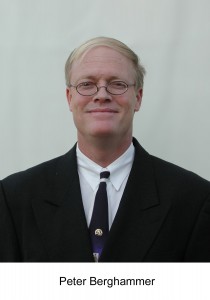
1960-2011
The SMILE Conference community has suffered a devastating loss with the passing of Peter Berghammer. Peter passed away unexpectedly Saturday evening, October 1st. Peter has been a supporter of SMILE since its inception in April of 2010. Peter was a great man; he was kind and brilliant, and he sincerely cared about law enforcement and the safety of law officers. His distinguished career is detailed below.
Peter gave his final presentation at The SMILE Conference in Dallas on September 29th, entitled “Social Media: Public Safety, Censorship and Dissent | Analysis of Tools and Trends in the Control of Social Media Dominance”. He had been a highly regarded speaker at all four SMILE Conferences to date; over the heads of some in attendance while others were in awe of his knowledge.
His presentation in Chicago – “How Do I Surveil Thee? – Let Me Count the Ways” is here. His presentation in Santa Monica – “Can the Social Media Genie be Put Back in the Bottle? The double edged sword facing law enforcement” is the most watched SMILE Conference video and is available here.
Peter leaves behind his wife Susan and their 20-month-old daughter, Abrielle.
The text below is the content from a press release issued by Public Communications Worldwide:
Garden Grove, CA October 5, 2011
– It is with a deep sense of sadness and loss that Public Communications/Worldwide (PC/W), a long-time Southern California independent public relations and marketing communications firm, announces the passing of Senior Strategist Peter Berghammer. Fifty-one year-old Berghammer died unexpectedly Saturday evening, October 1 from heart failure. Peter was an innovator and serial entrepreneur who worked on technology, aerospace and public-safety accounts for PC/W.
Though best known for his marketing acumen, Peter possessed a thorough understanding and appreciation for strategic alliances, acquisitions, and mergers. Through his leadership, The Copernio Holding Company, which he founded in 2001 and in which he served as Chief Executive Officer, quickly grew from an IT solutions provider to an organization with divisions handling consulting, research, warehousing, and logistics. Under his guidance, Copernio expanded from a single location to an international corporation with warehouses and offices in over 18 countries.
In 2003, he founded Future Formats, an offshoot of the research arm of Copernio, dedicated to the consumer electronics industry and photonics research.
No matter the endeavor, Peter’s goal always remained the same: to assist clients in achieving their business objectives through the intelligent and efficient use of information technology along with a strong infrastructure.
Immediately prior to founding Copernio, Peter served as Vice President of Sales and Marketing for the on-line marketplace startup Avolo. With an aggressive marketing and product development strategy, he took the company to a leadership position in e-commerce trade.
Prior to that, Peter served as Director of Worldwide Communications for aerospace, defense, and industrial fastening systems manufacturer Fairchild Fasteners (now part of Alcoa). He was a pioneer in the mid-1990s in the integration of CAD/CAM with solid modeling, and the integration of solid models with the internet – effectively building a proof of concept platform, which allowed for models to be designed and deployed in one location and manufactured in locations thousands of miles away.
Later, as an executive at EDS, Peter oversaw Fairchild’s web and network implementation strategy and deployment. He was responsible for developing Fairchild’s database-driven architecture, and laid the foundation for later integration of MRP, ERP, and ERP2 systems with the internet, joining facilities in over 20 countries.
Peter began his career in the late 1970’s with aerospace fastening company Rosan of Newport Beach, CA. Rosan was later acquired by Rexnord, then by Banner Aerospace, and eventually by Fairchild.
Peter stood out for his forward thinking and strong technical grasp of many issues in the industries with which he was involved. As such, he was active in a number of industry groups. These included being a life member of the American Institute of Aviation and Aerospace (AIAA), and a 20-year member of the Society of Aerospace and Automotive Engineers (SAE) and the Optical Society of America. He also belonged to The Center for Intelligence Studies, International Association for Cryptologic Research, and The SIIA: Software and Information Industries Association, in which he was an active participant on the Intellectual Property Sub-Committee, Search Engine watch group, and the Software as Service Sub-Committee.
Peter’s military associations included the U.S. Naval Institute and The Navy League, The National Defense Industrial Association (NDIA), and The Air Force Association. He is a life member of all of the aforementioned groups. He also belonged to the AFIO (Association of Former Intelligence Officers), NMIA (National Military Intelligence Association), IACR (International Association for Cryptologic Research), and MICA (Military Intelligence Corps Association).
Peter served his country with quiet effectiveness and always understood the importance of speaking truth to power. He brought this determination – to effectively make a difference and treat all with decency – to all of his relationships in the corporate world.
Among his educational credentials are the University of San Diego, the Goethe Institute, Cal Tech Engineering Management, and Stanford Law Intellectual Property and e-business. In 2005-2006, he was named a non-residential Fellow at Stanford Law: Center for Internet and Society researching security and crypotologic systems.
Peter was a well known speaker dealing with topics from consumer electronics to Intellectual Property, legislation, law through aerospace security, and integrated military logistics systems. He spoke on behalf of numerous organizations and at numerous international tradeshows.
As a husband and most recently, as a father, Peter found his happiest calling – and one to which he was wholly dedicated – as his family provided a newfound joy in which all his friends delighted and celebrated.
He is survived by his wife Susan van Barneveld (president of PC/W) and 20-month-old daughter Abrielle Ghislaine. The family lives in Huntington Beach, CA.
Daughter Abrielle was the light of Peter’s life. Her future education meant a great deal to him. In lieu of flowers, the family asks that contributions be made to an education fund for her at 19744 Beach Blvd., Suite 398, Huntington Beach, CA 92648.
A memorial service for Peter will be held on October 17 at 11:00 a.m. at Saint Mary’s by the Sea Catholic Church in Huntington Beach, CA.
— 30 —
Contact:
Public Communications Worldwide
Susan van Barneveld/Nicole Fait
(714) 891-3660,
memorial@pc-w.com
All products/services and trademarks mentioned in this release are the properties of their respective companies.
© 2011 Public Communications/Worldwide (PC/W). All rights reserved.
 The No. 1 rule in all social media is to create compelling content. Beyond that, there are a number of additional ways to get people to hit the like button for your Facebook page. Here are a dozen. Tell us what works for you.
The No. 1 rule in all social media is to create compelling content. Beyond that, there are a number of additional ways to get people to hit the like button for your Facebook page. Here are a dozen. Tell us what works for you.







